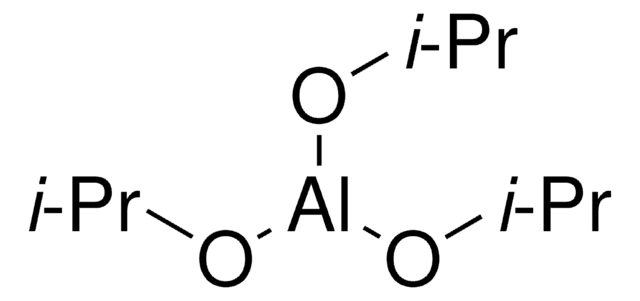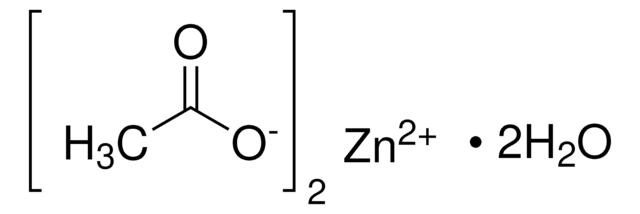930954
Aluminum nitrate nonahydrate
99.99% (trace metals basis)
Synonym(s):
Aluminum nitrate hydrate, Nitric acid aluminum salt nonahydrate, Aluminium nitrate
About This Item
alcohols: soluble
water: soluble (highly soluble)
Recommended Products
description
(2.5 - 3.5 at 50 g/L at 25 °C)
Quality Level
Assay
99.99% (trace metals basis)
form
powder
impurities
≤150 ppm (trace metals analysis)
mp
73 °C (lit.)
solubility
acetone: soluble
alcohols: soluble
water: soluble (highly soluble)
density
1.72 g/cm3
SMILES string
O.O.O.O.O.O.O.O.O.[Al+3].[O-][N+]([O-])=O.[O-][N+]([O-])=O.[O-][N+]([O-])=O
InChI
1S/Al.3NO3.9H2O/c;3*2-1(3)4;;;;;;;;;/h;;;;9*1H2/q+3;3*-1;;;;;;;;;
InChI key
SWCIQHXIXUMHKA-UHFFFAOYSA-N
Looking for similar products? Visit Product Comparison Guide
Related Categories
General description
Application
- As a precursor to prepare Al-ion electrolyte for dye-sensitized solar cells (DSSCs). It enhances photoconversion efficiency of solar cells.
- As a dopant to prepare Al-ZnO thin films for solar cells by sol-gel method.
- As a starting material to fabricate NiAl layered hydroxide electrode with high capacity and more stable cycling ability, for Li-ion batteries.
- To prepare α-alumina fibers by sol-gel processing. These dense fibers are used in the fabrication of catalytic supports, electronic devices, anticorrosion coating, and medical implants.
Signal Word
Danger
Hazard Statements
Precautionary Statements
Hazard Classifications
Eye Dam. 1
Storage Class Code
13 - Non Combustible Solids
WGK
WGK 1
Flash Point(F)
does not flash
Flash Point(C)
does not flash
Choose from one of the most recent versions:
Certificates of Analysis (COA)
Sorry, we don't have COAs for this product available online at this time.
If you need assistance, please contact Customer Support.
Already Own This Product?
Find documentation for the products that you have recently purchased in the Document Library.
Our team of scientists has experience in all areas of research including Life Science, Material Science, Chemical Synthesis, Chromatography, Analytical and many others.
Contact Technical Service







